What is Sericulture ?
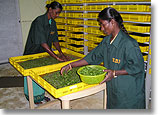
Sericulture is an agro-based industry. It involves rearing of silkworms for the production of raw silk, which is the yarn obtained out of cocoons spun by certain species of insects. The major activities of sericulture comprises of food-plant cultivation to feed the silkworms which spin silk cocoons and reeling the cocoons for unwinding the silk filament for value added benefits such as processing and weaving.
Why is Sericulture ?
- High employment potential
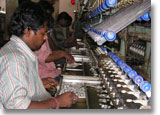
- 60 lakh persons are engaged in various sericulture activities in the country
- It is estimated that Sericulture can generate employment @ 11 man days per kg of rawsilk production (in on-farm and off-farm activities) throughout the year. This potential ispar-excellence and no other industry generates this kind of employment, specially in ruralareas, hence, sericulture is used as a tool for rural reconstruction
- Provides vibrancy to village economies
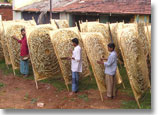
- About 57 % of the gross value of silk fabrics flows back to the cocoon growers with share of income to different groups.,
- 56.8 % to cocoon grower
- 6.8% to the reeler
- 9.1% to the twister
- 10.7% to the weaver
- 16.6% to the trade
Thus, large chunk of income goes back to the villages from the cities.
- Low Gestation, High Returns
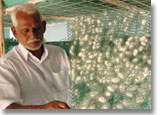
- Estimated investments of Rs.12,000 to 15,000 (excluding cost of land and rearing space) is sufficient for undertaking mulberry cultivation and silkworm rearing in one acre of irrigated land.
- Mulberry takes only six months to grow for commencement of silkworm rearing. Mulberry once planted will go on supporting silkworm rearing year after year for 15-20 years depending on inputs and management provided.
- Five crops can be taken in one year under tropical conditions.
- By adopting stipulated package of practices, a farmer can attain net income levels up to Rs.30000 per acre per annum.
- Women friendly Occupation

Women constitute over 60 % of those employed in down-stream activities of sericulture in the country. This is possible because sericulture activities starting from mulberry garden management, leaf harvesting and silkworm rearing is more effectively taken up by the women folk. Even silk reeling industry including weaving is largely supported by them.
- Ideal Programme for Weaker Sections of the Society
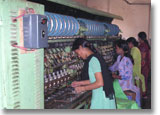
- Sericulture can be practiced even with very low land holding.
- Acre of mulberry garden and silkworm rearing can support a family of three without hiring labour.
- Features such as low gestation, high returns make sericulture an ideal programme for weaker sections of the society.
- Vast tracts of forest based tasar food plantations available in the country, if judiciously exploited for rearing tasar silkworms, can offer supplementary gainful employment for tribals.
- Eco-friendly Activity

- As a perennial crop with good foliage and root-spread, mulberry contributes to soil conservation and provides green cover.
- Waste from silkworm rearing can be recycled as inputs to garden.
- Dried mulberry twigs and branches are used as fuel in place of firewood and therefore reduce the pressure on vegetation/forest.
- Being a labour intensive and predominantly agro-based activity, involvement of smoke-emitting machinery is minimal.
- Developmental programmes initiated for mulberry plantation are mainly in upland areas where un-used cultivable land is made productive.
- Mulberry can also be cultivated as intercrop with numerous plantations.
- Mulberry being a deep-rooted perennial plant can be raised in vacant lands, hill slopes and watershed areas.
- Currently, only about 0.1 % of the arable land in the country is under mulberry cultivation.
- Satisfies Equity Concerns
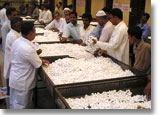
- Benefits of sectoral value-addition primarily accrue to rural households. As the end-product users are mostly from the higher economic groups, the money flows from high end groups to low end groups.
- Cases of landless families engaged in cocoon production using mulberry contracted from local farmers are common in some states.






